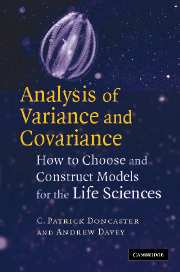Book contents
- Frontmatter
- Contents
- Preface
- Introduction to analysis of variance
- Introduction to model structures
- 1 One-factor designs
- 2 Nested designs
- 3 Fully replicated factorial designs
- 4 Randomised-block designs
- 5 Split-plot designs
- 6 Repeated-measures designs
- 7 Unreplicated designs
- Further Topics
- Choosing experimental designs
- How to request models in a statistics package
- Best practice in presentation of the design
- Troubleshooting problems during analysis
- Glossary
- References
- Index of all ANOVA models with up to three factors
- Index
- Categories of model
6 - Repeated-measures designs
Published online by Cambridge University Press: 13 November 2009
- Frontmatter
- Contents
- Preface
- Introduction to analysis of variance
- Introduction to model structures
- 1 One-factor designs
- 2 Nested designs
- 3 Fully replicated factorial designs
- 4 Randomised-block designs
- 5 Split-plot designs
- 6 Repeated-measures designs
- 7 Unreplicated designs
- Further Topics
- Choosing experimental designs
- How to request models in a statistics package
- Best practice in presentation of the design
- Troubleshooting problems during analysis
- Glossary
- References
- Index of all ANOVA models with up to three factors
- Index
- Categories of model
Summary
Repeated-measures designs involve measuring each sampling unit repeatedly over time or applying treatment levels in temporal or spatial sequence to each sampling unit. Because these designs were developed primarily for use in medical research, sampling units are often referred to as subjects. Those factors for which each subject participates in every level are termed ‘within-subject’ or ‘repeated-measures’ factors; levels of the within-subject factor are applied in sequence to each subject. Conversely, ‘between-subjects’ factors are grouping factors, for which each subject participates in only one level. Repeated-measures models are classified into two types, subject-by-trial and subject-by-treatment models, according to the nature of the within-subject factors (Kirk 1994).
Subject-by-trial designs apply the levels of the within-subject factor to each subject in an order that cannot be randomised, because time or space is an inherent component of the factor. Subjects (sampling units) may be measured repeatedly over time to track natural temporal changes in some measurable trait – for example, blood pressure of patients at age 40, 50 and 60, biomass of plants in plots at fixed times after planting, build-up of lactic acid in muscle during exercise. Likewise, subjects may be measured repeatedly through space to determine how the response varies with position – for example barnacle density in plots at different shore elevations, or lichen diversity on the north and south sides of trees.
- Type
- Chapter
- Information
- Analysis of Variance and CovarianceHow to Choose and Construct Models for the Life Sciences, pp. 179 - 228Publisher: Cambridge University PressPrint publication year: 2007
- 2
- Cited by



